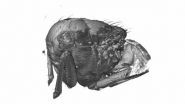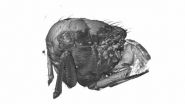(Press-News.org) VIDEO:
This is a 3D movie of a blowfly's flight muscles moving created by Oxford University and Imperial scientists using a new X-ray scanning technique.
Click here for more information.
The flight muscles moving inside flies have been filmed for the first time using a new 3D X-ray scanning technique.
3D movies of the muscles were created by a team from Oxford University, Imperial College London, and the Paul Scherrer Institute (PSI), using the PSI's Swiss Light Source, a powerful X-ray source. The movies offer a glimpse into the inner workings of one of nature's most complex mechanisms, the blowfly's flight motor, and could inspire new designs of micro air vehicle and other micromechanisms.
A report of this research, including the 3D movies, is published in this week's PLOS Biology.
In the time that it takes a human to blink, a blowfly [Calliphora vicina] can beat its wings 50 times, controlling each wingbeat using numerous tiny steering muscles – some as thin as a human hair. The membranous wings contain no muscles, so all of the flight muscles are hidden out of sight within the thorax.
'The thoracic tissues block visible light, but can be penetrated by X-rays,' said Dr Rajmund Mokso from the PSI. 'By spinning the flies around in the dedicated fast-imaging experimental setup at the Swiss Light Source, we recorded radiographs at such a high speed that the flight muscles could be viewed from multiple angles at all phases of the wingbeat. We combined these images into 3D visualizations of the flight muscles as they oscillated back and forth 150 times per second.'
The flies responded to being spun around by trying to turn in the opposite direction, allowing the scientists to record the asymmetric muscle movements associated with turning flight.
'The key question is how the fly's tiny steering muscles, which make up less than 3% of its total flight muscle mass, influence the output of the much larger muscles that power its flight,' said Professor Graham Taylor of Oxford University's Department of Zoology who led the research in Oxford. 'We found that blowflies have evolved a mechanism rather like the differential in a car; whilst the power delivered to the fly's wings on each side remains the same, the fly effectively 'brakes' on one side by diverting excess power into a steering muscle specialized to absorb mechanical energy.'
Professor Holger Krapp from Imperial College London's Department of Bioengineering said: 'We are excited because for the first time, we can visualise how the power and steering muscles in the fly's thorax work to enable stunningly aerobatic flight manoeuvres unmatched by any manmade device. Our study opens up the opportunity to uncover how the fly controls its sophisticated flight engine using the signals from different sensors and a brain no larger than the size of a pin head.'
Professor Taylor said: 'We hope that our new understanding of this clever design, which produces large, complex 3D movements using actuators that only generate small, simple one-dimensional motions, will inspire the development of new micro air vehicles and other micromechanical devices.'
Dr Simon Walker from Oxford University, joint first author of the study with Daniel Schwyn, said: 'The fly's wing hinge is probably the most complex joint in nature, and is the product of more than 300 million years of evolutionary refinement. The result is a mechanism that differs dramatically from conventional manmade designs; built to bend and flex rather than to run like clockwork.'
INFORMATION:
Watch movie 1: http://youtu.be/P6lBkK3J9wg
Watch movie 2: http://youtu.be/ehG4G-NOTQg
Watch movie 3: http://youtu.be/mVL6cWbOZRQ
In-fly movie: 3D video from inside flying insects
2014-03-25
ELSE PRESS RELEASES FROM THIS DATE:
Strictly limiting hours surgical residents can work has not improved patient safety
2014-03-25
TORONTO, March 25, 2014--Strictly limiting the number of hours surgical residents can work has not improved patient outcomes but may have increased complications for some patients and led to higher failure rates on certification exams, a research paper concludes.
Traditionally, doctors in the residency phase of their training spent very long hours in a hospital –often around-the-clock--so they could see a wide variety and high volume of patients. In the last 10 years, health authorities started limiting those hours in the hopes of improving patient safety and the education ...
Unravelling nerve-cell death in rare children's disease
2014-03-25
LA JOLLA, Calif., March 25, 2014 — A team of scientists, led by Stuart Lipton, M.D., Ph.D., professor and director of the Neuroscience and Aging Research Center at Sanford-Burnham Medical Research Institute (Sanford-Burnham), recently discovered why cerebellar granule cell neurons in patients suffering from ataxia-telangiectasia (A-T) were unable to repair DNA damage and thus died.
A-T is a hereditary condition that begins early in childhood, and causes a gradual loss of certain nerve cells in the cerebellum of the brain. A-T occurs in about 1 in 40,000 births, with symptoms ...
Brain differences in college-aged occasional drug users
2014-03-25
Researchers at the University of California, San Diego School of Medicine have discovered impaired neuronal activity in the parts of the brain associated with anticipatory functioning among occasional 18- to 24-year-old users of stimulant drugs, such as cocaine, amphetamines and prescription drugs such as Adderall.
The brain differences, detected using functional magnetic resonance imaging (fMRI), are believed to represent an internal hard wiring that may make some people more prone to drug addiction later in life.
Among the study's main implications is the possibility ...
Penn study: Distance from designated VA liver transplant center linked with greater risk of death
2014-03-25
(PHILADELPHIA) – Veterans with liver disease who live more than 100 miles from a Veterans Administration hospital that offers liver transplants are only half as likely to be placed on the liver transplant waitlist to receive a new organ compared to veterans who live closer to transplant centers, according to a new study from the Perelman School of Medicine of the University of Pennsylvania. The findings, which are published in the March 26 issue of JAMA, also reveal that the further liver disease patients live from these five transplant centers, the more likely they are ...
Treatment helps reduce risk of esophagus disorder progressing to cancer
2014-03-25
Among patients with the condition known as Barrett esophagus, treatment of abnormal cells with radiofrequency ablation (use of heat applied through an endoscope to destroy cells) resulted in a reduced risk of this condition progressing to cancer, according to a study in the March 26 issue of JAMA.
In the last 3 decades, the incidence of esophageal cancer has increased more rapidly that other cancers in the Western world. This type of cancer often originates from Barrett esophagus, a condition that involves abnormal changes in the cells of the lower portion of the esophagus, ...
Web-based alcohol screening program shows limited effect among university students
2014-03-25
Among university students in New Zealand, a web-based alcohol screening and brief intervention program produced a modest reduction in the amount of alcohol consumed per drinking episode but not in the frequency of drinking, overall amount consumed, or in related academic problems, according to a study in the March 26 issue of JAMA.
Unhealthy alcohol use is common among young people, including university students. Using an internet site to screening students for unhealthy alcohol use and intervene if appropriate has been suggested as an inexpensive means of reaching large ...
Effect of distance from transplant center on outcomes
2014-03-25
Among veterans meeting eligibility for liver transplantation, greater distance from a Veterans Affairs transplant center or any transplant center was associated with lower likelihood of being put on a waitlist or receiving a transplant, and a greater likelihood of death, according to a study in the March 26 issue of JAMA.
Centralization of specialized health care services is used to control costs, concentrate expertise, and minimize regional differences in quality of care. Although efficient, centralization may offset gains in care delivery by increasing the distance ...
Blood glucose measure appears to provide little benefit in predicting risk of CVD
2014-03-25
In a study that included nearly 300,000 adults without a known history of diabetes or cardiovascular disease (CVD), adding information about glycated hemoglobin (HbA1c), a measure of longer-term blood sugar control, to conventional CVD risk factors like smoking and cholesterol was associated with little improvement in the prediction of CVD risk, according to a study in the March 26 issue of JAMA.
Because higher glucose levels have been associated with higher CVD incidence, it has been proposed that information on blood sugar control might improve doctors' ability to ...
Study finds substantial decrease in use of cardiac imaging procedure
2014-03-25
There has been a sharp decline since 2006 in the use of nuclear myocardial perfusion imaging (MPI; an imaging procedure used to determine areas of the heart with decreased blood flow), a decrease that cannot be explained by an increase in other imaging methods, according to a study in the March 26 issue of JAMA.
Nuclear myocardial perfusion imaging accounted for much of the rapid growth in cardiac imaging that occurred from the 1990s through the middle 2000s. Edward J. McNulty, M.D., of Kaiser Permanente Medical Center, San Francisco, and colleagues conducted a study ...
Texas researcher: Peaches inhibit breast cancer metastasis in mice
2014-03-25
COLLEGE STATION – Lab tests at Texas A&M AgriLife Research have shown that treatments with peach extract inhibit breast cancer metastasis in mice.
AgriLife Research scientists say that the mixture of phenolic compounds present in the peach extract are responsible for the inhibition of metastasis, according to the study, which was this month published in the Journal of Nutritional Biochemistry.
"Cancer cells were implanted under the skin of mice with an aggressive type of breast cancer cells, the MDA-MB-435, and what we saw was an inhibition of a marker gene in the lungs ...




